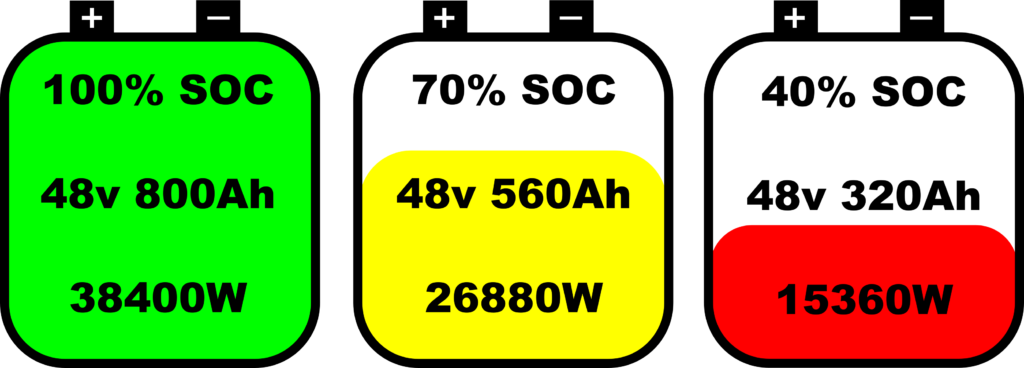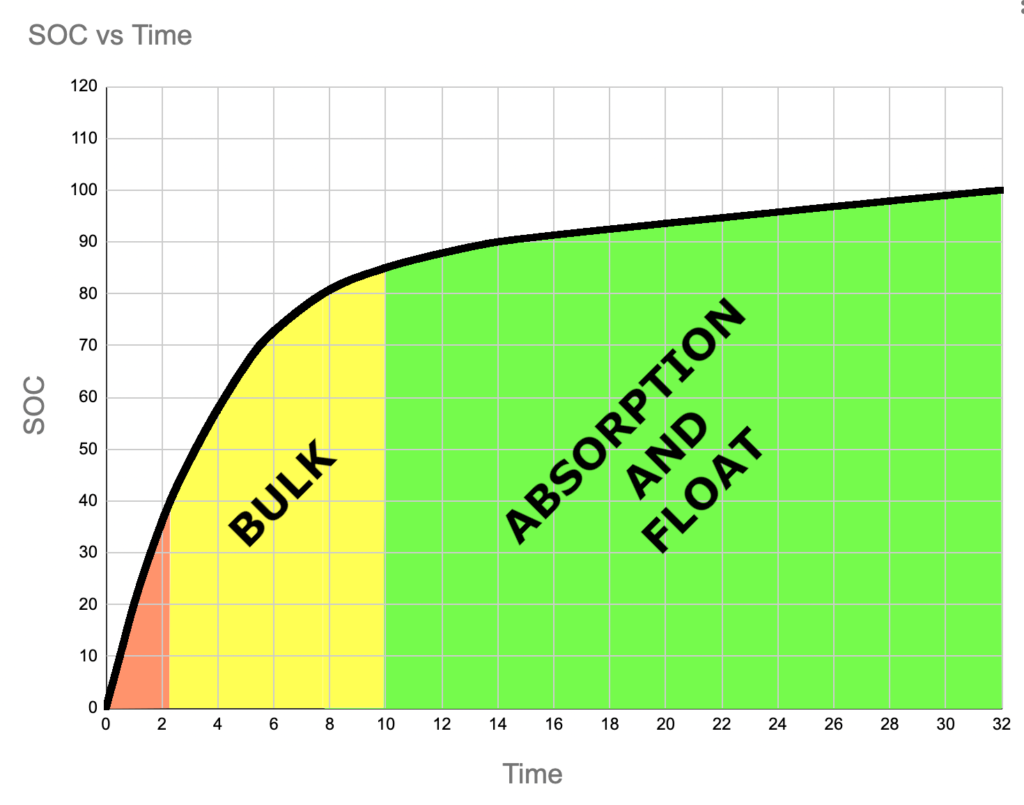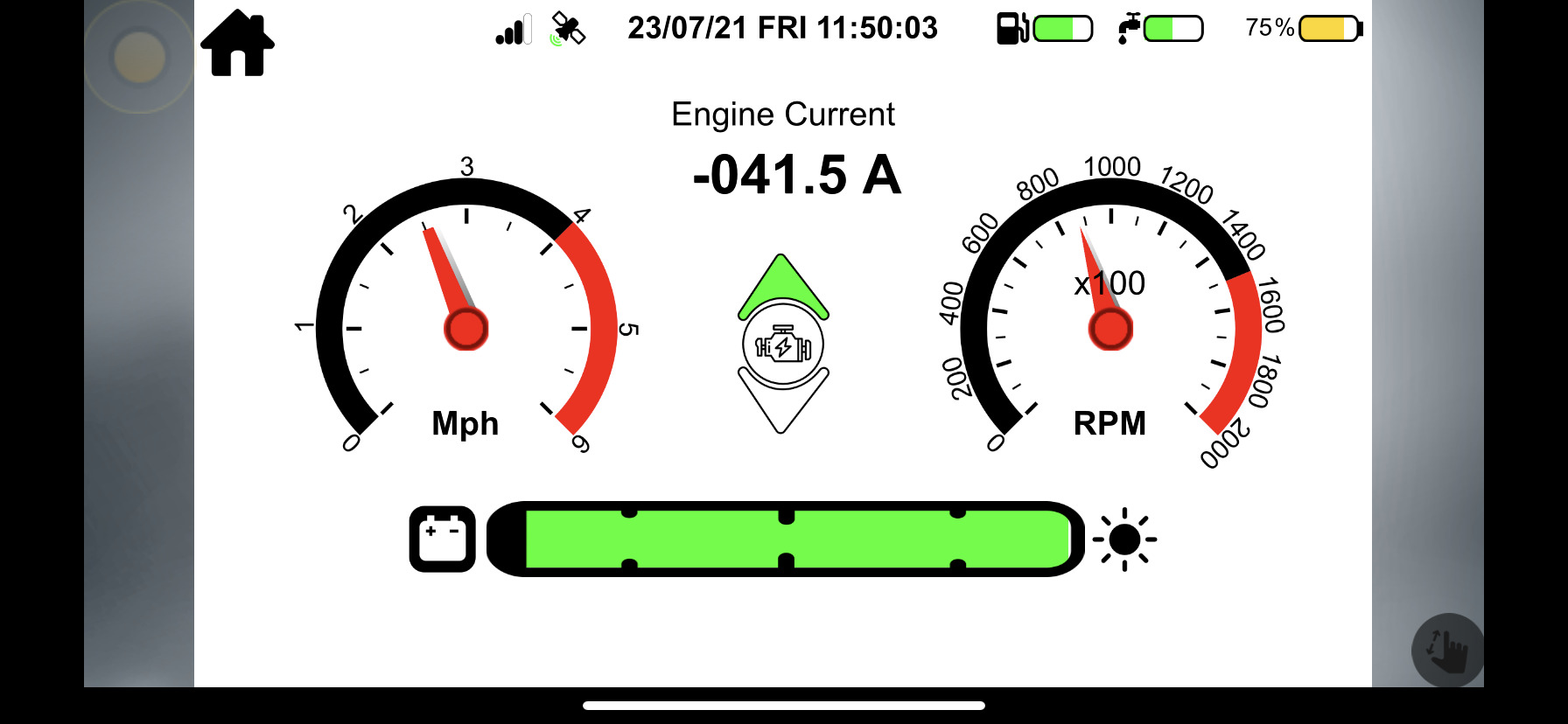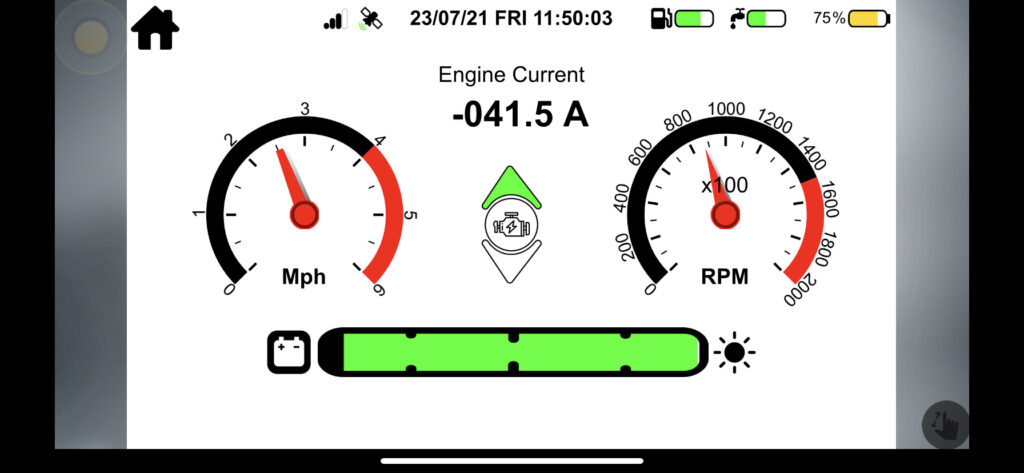We have been continuously cruising now for two months and have settled in to a regular routine. With nearly 300 miles under our belts, we are very comfortable with the way the Vetus E-Line engine is performing and have got used to the slightly different method of energy management that an electric serial hybrid, with Lead Carbon batteries, requires.
We have been truly amazed at the number of positive comments and questions that we have received from other boaters, lock keepers and gongoozlers but also disappointed at the level of misunderstanding and the amount of misinformation that exists about electric boat technology.
The two biggest misconceptions are that the technology is not there yet and that we can only cruise for a few hours. The technology on Old Nick is working very well, allowing us to cruise every day on canals and rivers., with absolutely no concerns about running out of power. Although we are not regularly doing the 8+ hour days of cruising that we used to do when we were younger, we can comfortably cruise for 8+ hours on an overcast day and have plenty of power left to do whatever we want to that evening.
It did take us a while to get our heads around not having to regularly re-charge the batteries back up to 100% “State of Charge” (SOC), as is the recommended norm for conventional Lead Acid batteries. We typically run our Lead Carbons, within a range of 60% to 90% SOC and apart from when we are on electric hook-up in a marina or on one of the “Electric Boat Charging Points” that we have found on the Thames, we never fully recharge them to 100%.

Above is a diagram showing the amount of usable power that Old Nick’s batteries provide. At 100% SOC the batteries store a whopping 38.4KWh of power and we can regularly discharge them (3000 cycles) down to 40% without reducing the life of the batteries. Even the occasional discharge to 20% SOC in extreme conditions, is apparently OK, but we will hopefully not be putting this to the test.
So if we set out with a fully charged set of batteries, we have approximately 23KWh of power or 480Ah at 48v before the batteries reach the critical 40% SOC, even with zero solar power, which is never the case. To put this in to cruising hours, at our preferred 800 RPM cruising speed we consume 30A, so we could cruise for 16 hours continuously.
In reality, unless we are cruising at night, there will always be some measure of solar power available and we are typically seeing between 5 and 10KWh per day during July. In fact, when the sun is strong, we often achieve what we like to call “State of Nirvana” when the engine is powered 100% by solar and taking no power at all out of the batteries.
As I am writing this article this evening, our batteries are around 75% SOC and tomorrow we will do a few hours cruising on the Thames and probably end up with SOC in the upper 60s. Then with an afternoon of solar we should see the SOC come back up in to the lower 70s. As we will both be showering tomorrow, we will run the generator for an hour, get a tank full of hot water and bring the SOC up by another 8-10%.
This pattern will continue all through the summer with us trying to get the maximum amount of solar whilst running the generator as little as possible. When we do run the generator, we will try and time it for when we need hot water, as the immersion heater does take a lot of battery power. We also never run the generator when the batteries are at 85% SOC or higher. as this is just not efficient, due to the typical charging pattern of lead carbon batteries (see below). It is much more efficient to run the generator at full load and bulk charge the batteries until they reach 80-85% and then when the Victron Quattro switches to absorption, knock the generator off and let any afternoon solar do the rest.

The graph above shows the typical charging times for Lead Carbon batteries. We only run the generator in the yellow “bulk” area and try to let the solar take care of the green “absorption and float” area. In our experience, we are seeing slightly quicker charge times than shown and expect to take 1 to 1.5hrs to increase the SOC by 10%, when running the generator.
In an ideal world, we would never have to run the generator, but as continuous cruisers, we have to be realistic and I now accept that it is part of our routine. The good news, is that it is very quiet (running at 1500 RPM), is more efficient than running a conventional diesel engine and alternator and can be run while under way. The AC output of the generator allows us to use the multi-stage charger of the Victron Quattro, which is more efficient than a normal DC alternator directly charging the batteries.
We were disappointed that the Vetus (Mitsubishi) generator has not yet been declared HVO compatible, as that would allow us to use this much greener fuel source, but the distribution network for HVO still needs to be expanded before this is a realistic option anyway.
All in all, we are very pleased with our power and propulsion set-up on Old Nick and feel we are being as green as is currently possible with the available technology. We hope this article gives a clear picture to others, thinking about an electric narrowboat, as to what life is like on a day to day basis, in the “cruising season”.



Your charging matches up to what Elon Musk has said. In a Tesla they suggest running the car between 30% and 80% charge, which suggests Lithium has similar charging. Wondering whether your heater has had much use or would electric heating have done the trick. All the best cruising now that you now have some freedom. UK is certainly leading the world in that decision.
Hi David, thanks for the positive comment and good to know that Tesla follow the “Old Nick” approach to battery charging 😉
We did use our diesel heater a lot this winter as there were quite a few days when the canal froze and the boat was covered in a few inches of snow. Not sure how efficient electric heating would be, certainly the electric immersion water heater is one of the least efficient systems on the boat.
It is really great to be cruising this summer, after spending nearly six months in the marina after “Old Nick” was launched.
Surely an electric resistance heater is almost 100% efficient! However if you are running a diesel generator for the power souce, the total system efficiency from fuel to hot water is likely poor, unless as you suggested in your article, you are also able to harness a good amount of the waste heat from the cooling loop.
Just roughly an IC engine in a three way split, between crankshaft output, cooling output, and exhaust gasses. Therefore if you can harness around half the cooling losses to heat hot water, you can get to maybe 50%. If the engine had/had an exhaust heat exchanger, and you could heat the radiators off this combined engine cooling, you might even get something like 70-80% or more. However it is all complexity, and the diesel heater probably achieves something like that already.
Hi Daniel, I am not so sure that a resistive heater might be the most efficient heat exchanger. Yes the conversion from electricity to heat is efficient, but it is the transfer of the heat to the water that seems poor – not enough surface area. Our 3KW kettle boils the water very quickly (less than 3 mins) to a much higher temperature but the 1.5KW immersion heater takes nearly an hour to reach 49degsC. I know that we are talking a larger volume of water and I have not done any serious research on this, but perhaps one of these new water heaters that just heat on demand might be a more efficient solution – higher power but for shorter periods and only heating what you use, rather than a whole tank.
I expect that will simply be the volume of water!
Q=mcΔT
Unless there is boiling on the surface of the immersion heater, which there certainly shouldn’t be, what goes in as electricity will come out as heat. At which point, not only is the immersion heater half the power rating, is is likely heating 50 times more water, at which point while the change in temp is only around 30 deg not 80deg the amount of energy is still a lot more.
Obviously with a tank you have stored hot water, and hence standing losses (ie it colds down with time because the insulation isn’t perfect) and you might find wrapping a suitable cylinder jacket around it is a good call, if the losses are negligible so will the difference! The obvious downside with an instant heater for most narrowboats is the instantaneous draw is more than can be provided by an landline, inverter, or the batteries. A decent power shower is 7kW or more. However with you battery bank, and gas-free cooking, you might actually be able do it, as long as you dont have the hob on during your shower!
Can I ask mate, is there any way to take the heat from the operating electric motor to store in something that’s designed to hold hot water, I’m thinking of something like an off peak water system where hot water from the motor is stored in an insulated tank and maintained by the running of the electric motor. Thinking down this track should give you enough hot water to shower and use each night🤓
Now add to this a near silent running small marine wind generator running at night maintaining the hot water while you sleep, well you should have almost so much hot 🔥 water you’ll be able to share it with others👍😉🙃🤓🥸
Most calorifiers have a coil that can be connected to a water cooled engine so that the heat from the engine is used to heat the hot water supply in the calorifier tank. We have ours connected to the generator and it works well.
The E-Line engine, being more efficient than a diesel, generates less heat and generally runs at around 30-40 degrees C which would never heat the water to the 45-55 degrees C that we run it at. We have the E-Line connected to a skin tank with a small and very quiet pump and it keeps the temperature very much under control.
Could Elon musks power wall be adapted for canal boats, it seems to work well in static homes why not a moving one?
Very interesting. I presume “So if we set out with a fully charged set of batteries, we have approximately 23KW of power or 480Ah at 48v…” should read 23kWh.
Have you considered solar thermal, or a gas heater, as an option for water heating?
Hi Daniel, yes there were a couple of references to KWh where I had left off the “h” but they are fixed now 🙂
“Old Nick” is a gas free boat, but you have piqued my interest on solar thermal and I will look in to that.
Hi mate, have you considered putting a marine wind generator at the bow of old nick ? There’s one that I’ve been looking at it’s called a DS 400 and at peak efficiency it’s supposed to provide 400 watts. It could give you your ‘Nirvana’ more often and even (if its as good as the paper work says) in the dark.
Safe Boating mate
Peter
Hi Peter, thanks for the suggestion, but I am not a great fan of a wind generator on a narrowboat. On a yacht, in open seas or in a coastal marina, it makes sense, but on canals and rivers there are always trees and other objects that act as wind breaks, reducing the strength of the wind. We are continuously cruising so storage is an issue, as it is impossible to cruise with the generator up with low bridges and tunnels. For a maximum output of 400W (30 knots of wind) it really is not worth the hassle and noise and also, we would need a 48v version, which are available but cost more.
I didn’t think of that, thanks for the reply
I’m curious. Your revs meter shows say 800 rpm on the outer ring, so why does the face of the gauge say x100?
Hi Mike,
Well spotted, that must have been left over from an earlier version when we thought it would be good to have 1,2,3,4,etc. labels but we found that the gauge looked OK with the longer numbers and was easier for people to read. I’ll ask Rob at Ortomarine to take out the x100 when we next do an update.
BTW, Porsche has revised it’s recharging algorithm in the latest version of its hybrid Panamera models such that by default recharging cuts off at 80%. This seems to be the evolving consensus among hybrid automobile manufacturers.
This might well be true, but is is for quite different reasons.
Different battery technologies like difference things lead-acid batteries for instance conventionally ‘like’ being fully charged, and will even take a reasonable amount of over charging safely, typically have no onboard cell balancing technology on board, but also don;t like being less than around 50% charged. But still take charge very slowly towards the end which is in efficiency from a generator, and lead-carbon batteries are a tweak on a standard VLRA cell which allows better partial state of charge life.
Lithium batteries on the other hand don’t like being charged fully to 100% (which is also very slow if done safely) but also don’t mind being discharged lower then a lead acid, so even though they are usually charged from the grid overnight operating between say 30 and 80% is better for them than between say 50 and 100% as you might a VRLA, as well as being the range they can be fast-charged within.
This might well be true, but is is for quite different reasons.
Different battery technologies like difference things lead-acid batteries for instance conventionally ‘like’ being fully charged, and will even take a reasonable amount of over charging safely, typically have no onboard cell balancing technology on board, but also don;t like being less than around 50% charged. But still take charge very slowly towards the end which is in efficiency from a generator, and lead-carbon batteries are a tweak on a standard VLRA cell which allows better partial state of charge life.
Lithium batteries on the other hand don’t like being charged fully to 100% (which is also very slow if done safely) but also don’t mind being discharged lower then a lead acid, so even though they are usually charged from the grid overnight operating between say 30 and 80% is better for them than between say 50 and 100% as you might a VRLA, as well as being the range they can be fast-charged within.
Hi Daniel. Our batteries are neither Lead Acid or Lithiums. They are Lead Carbons – just for clarification. And thanks for the heads up re page loading. We’ll sort that as soon as we can.
Hi Paul,
Lead Carbon Batteries are still a Lead Acid Technology. The carbon added to the lead is supposed to help reduce sulphation during partial state of charge conditions.
I’m not sure it removes all the sulphation though. So getting up to 100% every so often via solar or external electric is probably a good idea.
Jamie
Hi Jamie
Yes , I’m aware that LCs use LA technology and the carbon treatment of the plates reduces sulphation to almost zero. Bringing the SOC up to 100% every few weeks is good practice, if for no other reason than to re-synch the Victron SOC calculation, which is obviously an important measurement of the system. Thanks for getting in touch.
Paul
Hi Paul, I have been following your website with interest particularly from the technical side. I have a narrowboat with twin lynch motors powered by 48 Lithium cells (180 Ahr).in three banks. I am a bit disappointed with the CALB cells to be honest even though I have been careful with their management. I am now seriously considering switching to Lead Carbon batteries if I have any more problems with the cells or the BMS. I am happy with the Lynch motors but I only have a Victron BMV to give me info on the motor. The OrtoMate looks like a smart bit of kit. How many Watts of PV do you have?
Hi Tim, sorry to hear that you have had issues with your CALB cells. So far, we have been very happy with our Lead Carbons. When we first installed them, we got an occasional centre voltage deviation alarm on the Cerbo GX. We were only talking 3-4% (alarm was set at 2.5%) and that seems to have settled down now with typically <0.5% deviation between the top 12 batteries and the bottom 12 batteries. No issues with charging and a trip boat that Ortomarine built that has the same Leoch Lead Carbons as we have is regularly going down to 40% SOC - we tend to be a bit more conservative and try to avoid going below 60%.
"Ortomate" is a really great boat control system, which Kay and I use and rely upon everyday. Rob at Ortomarine really has created a unique and very desirable system that would be the thing I would miss most if I ever went on another boat.
We have 12x 160W panels, providing 1920W on peak solar days. All the best PAUL
Hi Paul
Many thanks for your reply that’s very interesting info.
I’m wondering what size propeller you have. Mine is 18 x 15 which I think is abit under propped.
Kind regards Tim
Hi Tim, well if you think you are under propped, you will definitely be sceptical of our prop which is 13″ x 9″. It is what Vetus recommended and it has proven to be very good. We did feel as if we were flying in the face of popular opinion, but after the electric trials event that Ortomarine organised and the calculations that Dave Jessie (owner of NB Perseverance another Ortomarine serial hybrid) did on prop sizes, the choice of prop for Old Nick appears to be correct. Certainly performance, acceleration, braking and efficiency seem to be fine and after being on the Thames for almost a month, we are very happy with this choice. All the best PAUL
Hi Paul, Thats really interesting info about the prop. Many thanks enjoy your cruising
Brgds Tim
Thank all for that info.
I am at present looking to start live aboard continues cruises life. I have played with solar for a few years mainly running a deep well pump supply for the house, with bit of lighting thrown in.
Am looking for a boat that would also allow me to safely travel coastal waters.
Have been speculating greatly about powering boat with solar and even water jet propulsion
I guess the big question for me is For say a 30ft river cruiser what size electric motor is required?
You really in-depth power conversion freaks
Or perhaps that’s me. Really loved the read thanks. Garry .
I guess you’d need to talk to the engine manufacturers? We have a 10Kw and, being mainly in canals. Have never really opened it up. Much of Vetus’s marketing is aimed at sailboats, so they clearly expect it to be used at sea. Thanks for getting in touch.
Hi thanks for the info 10kw, is quite a bit of power by my thinking, do you have any rough idea what load it draws when your using it.
Was I right in thinking your battery bank is 4 x 120 amp in series?
Hope you have a lovely day
Garry, 10kw corresponds to 208 amps at 48 volts. Some electric motors will go up to 15kw, 312 amps, and peak to 20kW, 416 amps but IMHO that is pushing the limit for a 48 volt supply.
In my opinion you do not want to go any higher than 48v for safety reasons.
Hi that is allot of amps at a full load
Was wondering how many amps you are drawing at poodling speed. 4knots.
I was thinking I may try a 1000 what ebike wheel with a paddel steemer, arrangement for Interist, just to find out how much power you need. Am always going to have good secondary motor system in place. I just like the idea of solar and when you get it working right it seems very reliable. Was also wondering wether there was any equipment you can pull through the water to generate power on a river how fast would it have to flow for a result, and wether if you were draging it would the drag defeat what it produces. Like trying stuff.
Gary, It’s going to depend on your boat shape and length. Paradoxically, shorter isn’t necessarily better due to wave making resistance.
4 knots is quite fast a canal boat would be using around 2-3kw at that speed so about 40 to 60 amps.
Paddles are very inefficient, that’s why the screw propellor was such a big step forwards…
Hi thanks for the Info.
Roughly half of the motor 10 khw capacity.
So not really sounding powerful enough to rely on for coastal boating.
Have got a fancy to boat around Britain. So need to come up with a hybrid power system.
When I say half its not wanting to run on maximum.
Garry, 10kw corresponds to 208 amps at 48 volts. Some electric motors will go up to 15kw, 312 amps, and peak to 20kW, 416 amps but IMHO that is pushing the limit for a 48 volt supply.
In my opinion you do not want to go any higher than 48v for safety reasons.
Thanks Jamie. We agree.